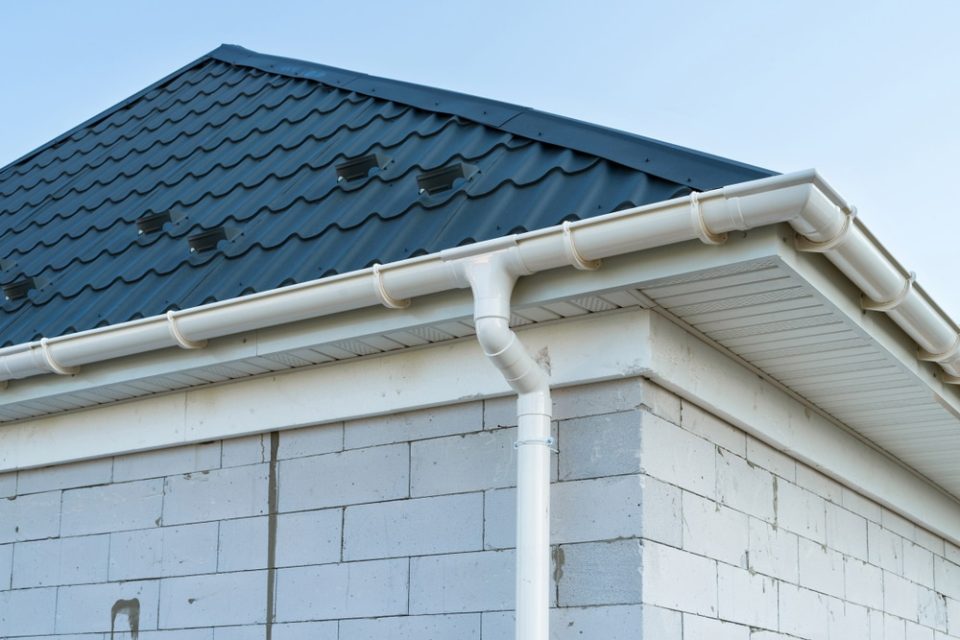When it comes to the overall health and longevity of a home, most homeowners tend to focus on the visible elements—roof shingles, windows, and walls—while the humble gutter system often remains underappreciated. However, gutters play a crucial role in protecting your home from water damage and preserving the structural integrity of your property. While they may not be the first thing that comes to mind when you think of roofing, gutters are an indispensable part of any well-designed roofing system.
In this article, we’ll explore the various aspects of gutters, including their function, types, materials, maintenance needs, and the importance of proper installation. By understanding the critical role gutters play in protecting your home, you can make informed decisions when it comes to their installation and upkeep.
The Vital Role of Gutters in Roofing
Gutters are designed to collect and direct rainwater away from the roof, preventing water from pooling around the foundation, seeping into the walls, or causing other forms of water damage. Without a functioning gutter system, rainwater can easily flow off the roof and into areas of the home that are not designed to handle it. This can lead to problems such as:
-
Foundation Damage: When water isn’t properly directed away from the house, it can accumulate around the foundation. Over time, this can cause erosion, cracks, and even foundation shifting.
-
Roof Damage: Clogged or poorly maintained gutters can cause water to overflow, potentially damaging the roof itself, leading to leaks and rotting materials.
-
Landscaping Erosion: Water runoff from the roof can damage your landscaping, washing away soil, plants, and mulch.
-
Basement Flooding: Inadequately drained water can find its way into basements or crawl spaces, leading to flooding, mold, and mildew growth.
Therefore, gutters are an essential component of your roofing system that contributes to the protection of your entire home.
Types of Gutters: Which One Is Right for You?
When selecting gutters for your home, it’s important to understand the different types of gutters available. Each type has its advantages and may be better suited to specific climates, architectural styles, and budgets. Here are the most common types of gutters:
1. K-Style Gutters
K-style gutters are the most popular gutter design in North America. They are named for their shape, which resembles the letter “K” when viewed in profile. These gutters are typically made of aluminum or steel and are known for their efficiency and durability. K-style gutters are often installed on modern homes due to their sleek, angular design, which complements contemporary architectural styles.
Pros:
-
Efficient water flow: The design allows for a large capacity to carry water away from the roof.
-
Aesthetic appeal: K-style gutters come in a variety of finishes and sizes, and their sleek, smooth design complements many home styles.
-
Versatility: They can be made from a range of materials, including aluminum, copper, and vinyl.
Cons:
-
Clogging: K-style gutters can accumulate debris easily, leading to clogs if not regularly cleaned.
-
Potential for damage: The sharp edges can be prone to denting or damage, particularly in areas with severe weather.
2. Half-Round Gutters
Half-round gutters, as the name suggests, have a semi-circular shape. This traditional gutter style is often found on older homes and historic buildings, though it can still be a charming addition to modern houses, particularly those in classic architectural styles.
Pros:
-
Easy to clean: The smooth, rounded design allows for debris to easily wash away, reducing the risk of clogs.
-
Aesthetic charm: Half-round gutters add a distinct and timeless appeal to your home’s exterior.
Cons:
-
Lower water capacity: Half-round gutters tend to have a smaller capacity compared to K-style gutters, meaning they may not be ideal for areas with heavy rainfall.
-
Higher maintenance: Though they are easier to clean, they may require more frequent maintenance to ensure proper water flow.
3. Fascia Gutters
Fascia gutters are integrated into the fascia board of the roof, making them less visible than traditional gutters. This seamless design eliminates the need for visible brackets, offering a more streamlined and modern look.
Pros:
-
Aesthetic appeal: The seamless design makes fascia gutters ideal for homeowners seeking a sleek and minimalist appearance.
-
Durability: Since they are integrated into the roof structure, fascia gutters tend to be sturdy and resistant to damage.
Cons:
-
Cost: Fascia gutters tend to be more expensive due to the specialized installation process.
-
Complexity of installation: Installing fascia gutters can be more labor-intensive compared to traditional gutter systems.
Gutter Materials: Choosing the Best Option
The material of your gutters plays a significant role in their performance, durability, and appearance. Different materials have different strengths and weaknesses, and your choice will depend on your specific needs and budget. Here are some of the most common gutter materials:
1. Aluminum
Aluminum gutters are by far the most popular choice in residential homes due to their lightweight nature, resistance to rust, and affordability. They come in a wide range of colors and finishes, making them highly customizable.
Pros:
-
Lightweight: Easy to handle and install.
-
Rust-resistant: Aluminum gutters do not rust, making them ideal for areas with high humidity or coastal regions.
-
Affordable: Among the most cost-effective gutter options available.
Cons:
-
Denting: Aluminum gutters are more prone to denting from impacts than more durable materials.
-
Less durable than other metals: While aluminum is rust-resistant, it can still be susceptible to weathering and wear over time.
2. Copper
Copper gutters are known for their luxurious appearance and exceptional durability. These gutters age beautifully, developing a characteristic patina over time that can add a unique charm to the home.
Pros:
-
Aesthetic appeal: Copper gutters are highly sought after for their elegance and the unique greenish patina they develop over time.
-
Durability: Copper is resistant to corrosion and can last for decades with minimal maintenance.
-
Low maintenance: Copper gutters require very little upkeep.
Cons:
-
Cost: Copper gutters are one of the most expensive options available.
-
Prone to theft: Due to their high value, copper gutters are sometimes targeted for theft.
3. Vinyl
Vinyl gutters are another affordable option, often chosen for their ease of installation and low maintenance requirements. These gutters are typically lighter and less durable than metal alternatives but can be effective in moderate climates.
Pros:
-
Cost-effective: Vinyl gutters are one of the least expensive options available.
-
Easy installation: Vinyl is lightweight, making it easy to install for DIY homeowners.
-
Low maintenance: Vinyl gutters don’t require painting or frequent cleaning.
Cons:
-
Less durable: Vinyl gutters are prone to cracking in extreme temperatures, particularly in cold climates.
-
Limited color options: While vinyl gutters come in various colors, the color can fade over time due to exposure to the sun.
4. Steel
Steel gutters are heavier and more durable than aluminum or vinyl, making them an excellent choice for regions with extreme weather. However, they are more prone to rust unless coated with a protective layer.
Pros:
-
Durability: Steel gutters are strong and can handle heavy rainfall and snow.
-
Variety: Steel gutters can be coated with different finishes, such as galvanized or stainless steel, to improve their resistance to rust and corrosion.
Cons:
-
Rust: Steel gutters can rust over time if they are not properly maintained or coated.
-
Cost: Steel gutters tend to be more expensive than aluminum or vinyl options.
Gutter Maintenance: Keeping Them in Top Shape
Regular maintenance is essential to ensuring the longevity and efficiency of your gutter system. Neglecting your gutters can lead to blockages, leaks, and water damage that can result in costly repairs. Here are some tips for keeping your gutters in good condition:
-
Regular Cleaning: Clean your gutters at least twice a year—once in the spring and once in the fall. This will prevent debris like leaves, twigs, and dirt from accumulating and causing clogs.
-
Check for Leaks: Inspect the seams of your gutters for leaks, particularly after heavy rainfall. If you notice any leaks, seal them promptly to prevent further damage.
-
Ensure Proper Drainage: Make sure that the downspouts are clear of debris and are directing water away from the foundation of your home.
-
Inspect for Damage: Look for any signs of damage, such as sagging gutters, rust, or cracks, and repair them as needed.
Conclusion
Gutters are a small but vital component of your home’s roofing system. They protect your home from water damage, preserve the integrity of your foundation, and ensure that rainwater is efficiently directed away from the property. With the variety of gutter types and materials available, it’s essential to choose the right system for your home’s needs and local climate.
By maintaining your gutters regularly and addressing any issues promptly, you can extend the life of your roofing system and avoid expensive repairs down the road. Whether you’re installing new gutters or upgrading your existing system, understanding the role of gutters in protecting your home will help you make an informed, lasting choice.

